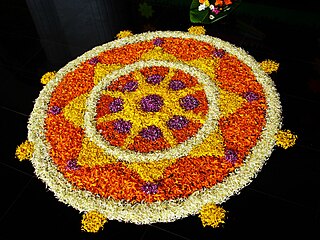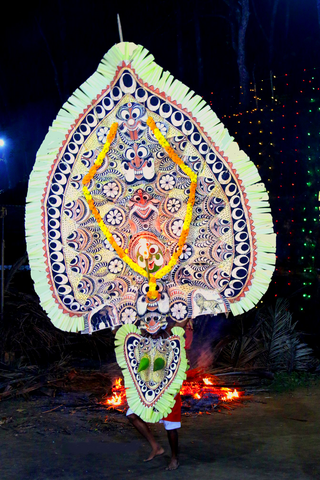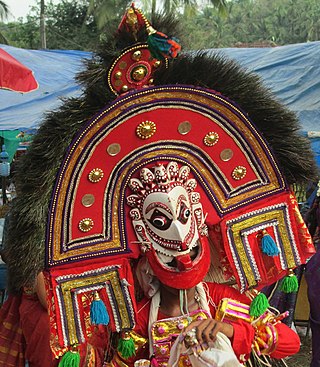
Onam is an annual harvest and Hindu cultural festival celebrated mostly by the people of Kerala. A major annual event for Keralites, it is the official festival of the state and includes a spectrum of cultural events.

The culture of Kerala has developed over the past millennia, influences from other parts of India and abroad. It is defined by its antiquity and the organic continuity sustained by the Malayali people. Modern Kerala society took shape owing to migrations from different parts of India and abroad throughout Classical Antiquity.

The Indian state Kerala is well known for its diverse forms of performing arts. The various communities in Kerala contribute to its rich and colourful culture. The most important traditional art forms of Kerala are Kathakali, Kalaripayattu,Mayilpeeli Thookkam, Koodiyattam, Theyyam, Mohiniyattam, Thullal, Padayani, Pulikali, Thiruvathirakali, Chakyarkoothu,Chavittunadakam, etc.

Mudiyettu is a traditional ritual theatre and folk dance drama from Kerala that enacts the mythological tale of a battle between the goddess Kali and the demon Darika. The ritual is a part of the bhagavathi or bhadrakali cult. The dance is performed in bhadrakali temples, the temples of the Mother Goddess, between February and May after the harvesting season.

Puli kali is a recreational folk art from the state of Kerala, India. It is performed by trained artists to entertain people on the occasion of Onam, an annual harvest festival, celebrated mainly in the Indian state of Kerala. On the fourth day of Onam celebrations, performers painted like tigers and leopards in bright yellow, red, and black shake their bellies and dance to the beats of instruments like Chenda and Chengila. The literal meaning of Pulikkali is 'The tiger dance' hence the performance revolves around the theme of tiger hunting. Folk art is mainly practiced in the Thrissur district of Kerala. The best place to watch the show is at Thrissur on the fourth day of Onam, where Pulikkali troupes from all over the district assemble to display their skills. The festival attracts thousands of people to the Thrissur city. Pulikkali is also performed during various other festive seasons.

Sarkaradevi Temple is one of the most important temples in South India. It is situated Chirayinkeezhu town in Thiruvananthapuram district. Tradition accords a remote antiquity to this temple. Its main deity is Bhadrakali. The Sarkaradevi Temple assumed a significant status for many reasons and rose to historical importance mainly with the introduction of the famous Kaliyoot festival by Anizham Thirunal Marthanda Varma, the Travancore sovereign, in 1748. The Sarkaradevi Temple have some basic attachment with Nakramcode Devi Temple which located in Avanavanchery, Attingal.

Kanniyar Kali is a folk dance ritual performed in Temples of villages in Alathur and Chittur Taluk of Palakkad district of Kerala. The event is usually a part of Vishu celebrations of the village and usually succeeds the Vela and is usually performed during the months of April and May. It is an agricultural festival dance of Nair community. Kanniyar Kali, despite the name of the Virgin, does not have anything to do with the Kannaki cult.
Kothachira is a village in central Kerala, southern India. The village is located on the borders of Thrissur and Palakkad districts and is also known as Kothara.

Poothan and Thira is a ritualistic folk art performed mainly in the Valluvanad region of central Kerala in India, in which people dance in costumes representing Poothan is the lieutenant of Kali, and Thira, the goddess Kali, to the accompaniment of drummers. Thudi a small drum using for poothan, and heavy drum para accompanying thira.
Theeyaattam also known as Theeyaattu (Tīyāttu) is a traditional temple dance form of Kerala.

Onathallu, also known as Kayyāmkali or Avittathallu is an Indian martial dance and a semi-contact combat sport performed in Kerala during the festival of Onam. In some places, it takes the form of non-stop fighting, while in some other places, it is a combat sport with actual fight.

Padayani, also known Padeni, is a traditional folk dance and a ritual art from the central portion of the Indian state of Kerala. A ceremonial dance involving masks, it is an ancient ritual performed in Bhagavati temples. The dance is performed in honor of Bhadrakaali. Meaning, a 'row of warriors', Padayani is an art form that blends all music, dance, theatre, satire, facial masks, and paintings. It is part of worship of Bhadrakali and is staged in temples dedicated to the goddess from mid-December to mid-May. Padayani is unique to central Travancore, comprising the Pathanamthitta and Kottayam districts of Kerala. It is also performed in adjoining regions of Kollam, Alappuzha districts.

The MajorVellayani Devi Temple is a highly revered shrine in Kerala, India, dedicated to goddess Bhadrakali. The shrine is situated in Vellayani 1.5 km west of Vellayani junction, 12 km southeast of Thiruvananthapuram on the eastern bank of Vellayani Lake. The temple is under the management of Travancore Devaswom Board. The temple structure has a bronze roof with traditional art work and carries Dravidian architecture. The temple has eastern and northern towers called Gopurams with statues of different Gods sculptured in them. The Gopurams function as gateways through the walls that surround the temple complex.

Parichamuttu Kali is an Indian martial-arts dance form of Kerala practiced by the Saint Thomas Syrian Christians who trace their origins to the evangelistic activity of Thomas the Apostle in the 1st century and also by Latin Catholics of Malabar residing in the coastal regions of kerala. It is performed by men bearing swords and shields and follows the movements and steps of Kalarippayattu. This dance is closely related to Margam Kali. Parichamuttu Kali was also performed by Harijans.

Poothamkali is folk art form in the state of Kerala, India. This art form uses various types of decorations in the costume. It is usually performs in the Bhagavathy temples of Malappuram district. It is based on the myth of Durga and her combat with Darika.
Malavazhiyattam also known as MalavayiyattamKariniliyattam or Cheruniliyattam is a ritualistic folk art of the Paraya community in Kerala, India. It is music and drama performed to please Malavazhi, a mother goddess worshiped by the Parayas and installed in their homes.
Ninabali is a ritualistic performing art form popular in Kannur, Kozhikode districts of northern Kerala, India. It is a folk art performed by the Malaya community. This art form, which is performed in homes as part of Hinuist exorcism ceremonies, depicts the battle between Bhadrakali and the asura Darika.

Chozhikali, also spelled as Chozhi Kali, is a folk dance popular in Central Kerala, India. There are two types of Chozhikali: Thiruvathirachozhi and Kudachozhi. It is performed by the Hindu community in Palakkad and Thrissur districts of Kerala.

Kaliyoottu also known as Kali natakam is a ritualistic performing art popular in Thiruvananthapuram Kollam districts of southern Kerala, India. It is a folk art related to the battle between Bhadrakali and the asura Darika.

Nayadikali is a traditional folk art form that exists among the Panan community of the Valluvanad region in Kerala, India. It is usually performed ahead of the Pooram festival at the Devi temples in the region, for the good and prosperity of the people and region.
















